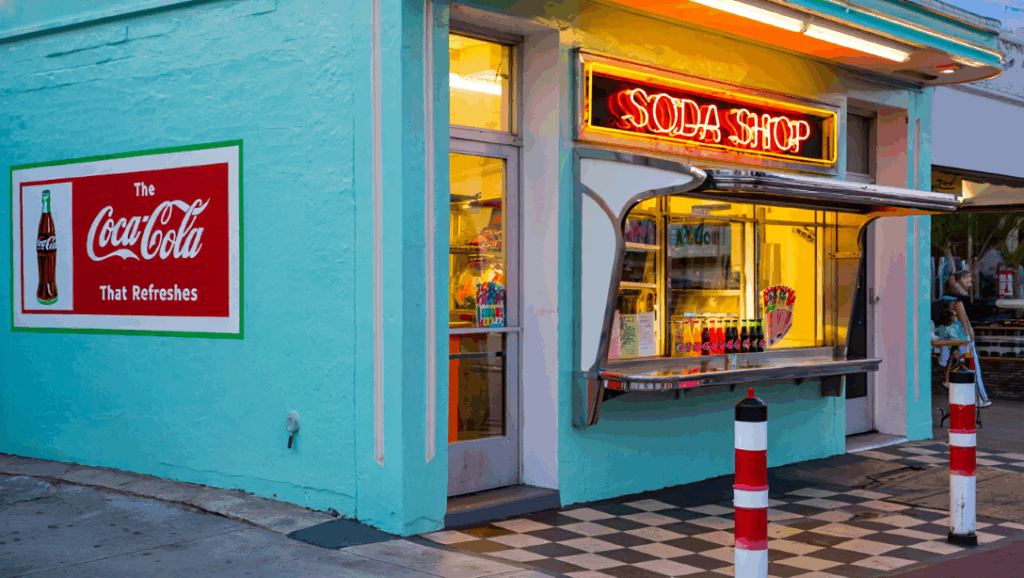Why Soda Shops Became Cultural Icons
The American soda fountain began as a pharmacy counter that served tonics and mineral waters. By mid-century, it had become a social hub where teenagers met after school, families shared sundaes on Friday nights, and travelers found the comfort of a grilled cheese and a thick malt. The look of the retro soda shop carried a promise. Stainless steel gleamed under bright lights. Tiles shone in checkerboard patterns. Stools lined the counter like friendly exclamation points. Music poured from a jukebox while neon hummed above the doorway. This scene felt modern in the fifties, and it still feels optimistic now. The design invites people to slow down, talk, and taste something sweet.
For historical context on fountains and pharmacy culture, the collections at the Smithsonian and essays at American Heritage provide helpful background on how the soda fountain moved from medicine to memory.
The Core Visual Language
Counter Seating And Social Flow
A soda fountain lives at the counter. Stools sit on chrome bases with round seats in vinyl that cleans easily and reflects light. The setup encourages informal conversation. You slide onto a stool, chat with the person next to you, and talk to the server while you watch a banana split take shape. The plan removes distance. Guests feel included in the making of their treats, which turns service into a small performance.
Checkerboard Floors And Glossy Surfaces
Black and white tiles create rhythm for the eye and guide movement through the room. The pattern pairs with walls that are often tiled in white or painted in cream to keep the space bright. Stainless worktops bounce light back toward the ceiling. Glass domes cover pies and cakes. The total effect feels clean, energetic, and a little theatrical.

Neon Signage And Color Play
Neon signage is the heartbeat of a classic shop. Hot pink and ice blue tubes curve into promise-filled words like Shakes or Open Late. The glow reflects in chrome and glass, which makes every surface feel lively. Neon also helps people find the shop from the street at night. A good sign turns a storefront into a landmark.
Jukebox As Gathering Point
Jukebox culture built a soundtrack for ice cream runs and first dates. Teenagers pooled coins to choose a song. Parents smiled at familiar verses. The machine offered a small ritual of choice. You flip through title cards, then press a button and wait for the arm to lift a record. The blend of light, sound, and anticipation made music a central part of the room.
Materials That Define Authentic Style
Chrome Vinyl And Glass
Chrome frames the bar rail and the stool bases. Vinyl wraps seats in candy colors such as cherry red or seafoam green. Glass syrup pumps and sundae dishes sparkle under task lights. These materials are durable, which is why they were chosen in the first place. They also photograph beautifully, which is why modern shops still use them.
Tile And Terrazzo
Tile is friendly to spills and easy to sanitize. Terrazzo offers a period-correct look with flecks that catch light. If you renovate a space and discover an old terrazzo floor, keep it. The material adds age in a way that fresh tile cannot replicate. For images and restoration examples, browse preservation features at the National Trust for Historic Preservation.
Color Palettes That Communicate Era
Pastel Optimism
Creamy pink, mint green, and baby blue suggest the early postwar period. Pair these with white walls and chrome trim to keep the look light. Pastels read friendly and nostalgic. They also help ice cream and pies stand out since food colors pop against soft backdrops.
Bold Contrast For Late Fifties Energy
Cherry red, cobalt, and inky black create a punchier look that works with checkerboard floors and strong neon. These colors suit car-themed diners and soda shops that lean into rock and roll. If you want a period touch, choose a single bold color for stools and a neutral for the rest, so the room does not feel busy.
Menu Items That Shape The Space
Malts And Sundaes As Stage Props
A malt shop design uses menu classics as part of the visual story. Tall fountain glasses show off layers of sauce and ice cream. Whipped cream mounds rise above the rim with a cherry on top. Banana splits arrive in glass boats that curve like tiny canoes. Each item brings height and shine to the counter, which strengthens the look of the room.
Griddles, Soda Guns, And Syrup Pumps
The sound of a griddle and the hiss of a soda gun add sensory texture. Syrup pumps line the back bar with labels for chocolate, caramel, strawberry, and butterscotch. The arrangement makes a small theater out of service. For culinary history and recipe context, scans of vintage fountain manuals and essays on soda culture appear in the Internet Archive and in food history pieces at Serious Eats.
How The Look Shifted Over Time
From Pharmacy To Youth Hangout
Early fountains attached to drugstores emphasized the tonic tradition. Counters were simple and signage was modest. As teen culture grew, owners added brighter colors and jukeboxes. Posters of movie idols appeared on walls. Service slowed slightly by design so friends would linger and order second rounds. The soda shop became a social map for small towns and city neighborhoods.
Influence Of Car Culture
Drive-in theaters and road trips encouraged shops to extend hours and to create stronger neon for visibility. Parking lots became part of the experience. A couple could split a sundae inside, then take a shake out to the car before heading to a movie. The shop sat between school and the screen, which meant it often became the most important meeting point in a week.
Television And The Shift To Diners
Television kept more families at home in the evening. Many shops responded by expanding their menus to include burgers and breakfast plates. Counters grew longer. Booths multiplied. The soda shop blended with the diner, and the pure fountain became rarer. Yet the visual grammar survived. You still see chrome, tile, neon, and a jukebox even when the griddle hums next to the blender.
Revival And Reinvention
The Nostalgia Wave
Designers and restaurateurs return to the retro soda shop look whenever people crave warmth and community. New shops open with pastel palettes and curated jukeboxes. Museums mount shows that highlight the cultural meaning of the fountain. Travel writers spotlight towns where an original counter still serves phosphates and egg creams. For small town guides that list vintage stops, Roadtrippers and Atlas Obscura provide playful routes.
Modern Twists That Respect The Past
Chefs experiment with salted caramel and brown butter pecan. Bar teams add adult soda fountain menus during evening hours with boozy shakes that nod to the classic format. Designers integrate energy-efficient lighting that mimics the warm look of neon. Some shops install digital jukeboxes while keeping a vintage cabinet as a visual centerpiece. Reinvention works best when it honors the spirit of gathering and the tactile joy of the old materials.
Practical Styling Tips For An Authentic Look
Start With The Counter
If you design or refresh a space, invest in the counter and stools first. The counter is the heart. Choose a radius corner so elbows and trays glide comfortably. Select stools that spin without wobble and that return to the center on their own. Small mechanical choices affect how the room feels and how long guests want to stay.
Light For Shine Not Glare
Aim the light at stainless steel and glass to make surfaces glow without hurting eyes. Use warm temperature bulbs for table lamps and cool bulbs above the work line if you want a bright classic feel. Accent your neon signage so the tubes read clearly in photos. A photographer can help you test exposure so the sign remains legible while faces look natural.
Curate Music With Care
A shop can play fifties favorites without feeling stuck in time. Build a playlist that includes doo wop, early soul, and modern tracks with a retro spirit. Invite customers to select a limited number of songs per hour so the soundtrack feels communal rather than chaotic. If a real jukebox is feasible, maintain it carefully and keep title cards fresh.
Display Menus And Prices With Charm
Hand-painted menu boards or printed cards in simple frames feel right. Keep typography bold and legible. Place a few vintage advertisements for ice cream brands or soda syrups on a gallery wall. Balance nostalgia with clarity so guests can find what they want quickly.
Social Rituals That Keep The Spirit Alive
The Birthday Sundae
Offer a free cherry and a candle on a guest’s birthday sundae. Announce it lightly and let the room cheer. Small rituals like this turn a shop into a community stage.
After School Club
Create a short happy hour for students with small discounts on floats and grilled cheese. A room full of homework and laughter will feel like the classic after-school scene that made soda shops famous.
Community Events
Host vinyl nights where regulars bring records to play. Plan a classic car evening once a month with parking for show and shine near the door. Pair with local historians who can share short talks about the town’s original fountains. These events link the room to the larger story of place.
Food And Flavor Notes For Today
Quality Dairy And Thoughtful Syrups
Modern guests care about ingredients. Work with local dairies for fresh milk and ice cream. Cook syrups in-house when possible. A simple chocolate sauce can taste extraordinary with real cocoa and a pinch of salt. Fruit syrups made from seasonal berries win hearts and create a natural color that looks beautiful in clear glass.
Classic Techniques That Still Impress
Whip cream to soft peaks in small batches. Pour sodas with a slight tilt and a swirl so foam crowns the glass without spilling. Build sundaes with a consistent pattern so every order photographs well. The goal is a sense of occasion that feels effortless.
For recipe deep dives and technique guides, check the archives at Taste and the soda fountain histories collected by independent writers on Serious Eats.
Picture Ideas And Alt Text Notes
Counter And Service
Wide shot of the counter with stools and a server pulling a malt. Alt text. Chrome stools face a bright bar where a milkshake whirls in a blender.
Details And Texture
Close frame of syrup pumps and sundae glasses. Alt text. Glass bottles and pumps line a stainless shelf with light reflecting in curves.
Neon And Night
Exterior at dusk with neon signage glowing. Alt text. A pink and blue sign reads Open while people gather at the door.
Music And Mood
Jukebox with guests choosing a track. Alt text. Friends scroll title cards and smile as the selection clicks into place.
Final Thoughts
The retro soda shop is more than a set of colors and materials. It is a social design that invites conversation and celebrates simple pleasures. Build the room around the counter and the glow of light on the chrome. Keep music communal and menus clear. Honor classics while you explore new flavors. Whether you restore an original fountain or create a fresh room with vintage spirit, the mix of diner decor, neon signage, and jukebox culture will always feel like an open door to joy.
